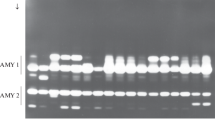Summary
Six populations of F2-derived lines of barley and their parents were evaluated for heading date, plant height, grain yield, bundle weight, and harvest index in a replicated experiment in the field. These data were used to estimate the minimum number of effective factor pairs segregating for each trait, the number of favorable factors contributed by each parent in a cross, and the frequencies and magnitudes of transgressive segregates.
Heading date, plant height, and harvest index were controlled by three to four effective factor pairs, whereas grain yield and bundle weight were controlled by five or more.
All three H. spontaneum strains used in our study contributed one or more useful genes for each of the traits, grain yield, heading date, plant height, bundle weight, and harvest index. Therefore, it seems that H. spontaneum can be a useful source of favorable genes for quantitative traits, especially for grain yield, which could be incorporated into barley varieties readily by backcrossing. Transgressive segregates for grain yield in the interspecific crosses may provide the basic materials for improving the productivity of cultivated barley varieties.
Similar content being viewed by others
References
Barbacki, S. G., G. Kurhanska, T. Adamski & M. Surma. 1976. Transgressions in barley (Hordeum sativum Jess.). V. Transgression and heterosis-their importance for plant evolution and breeding. Genet. Pol. 17: 77–82.
Castle, W. E. & S. Wright, 1921. A method of estimating the number of genetic factors in cases of blending inheritance. Science NS 54: 223.
Efron, Y. & H. L. Everett, 1969. Evaluation of exotic germplasm for improving corn hybrids in northern U.S. Crop Sci. 9: 44–47.
Frey, K. J., 1976. Plant breeding in the seventies: Useful genes from wild plant species. Egypt. J. Genet. Cytol. 5: 460–482.
Harlan, J. R., 1976. Genetic resources in wild relatives of crops. Crop Sci. 16: 329–333.
Hehn, E. R., 1948. The inheritance of agronomic characters in barley. Ph. D. dissertation. Iowa State University, Ames, Iowa.
Lawrence, P. L., & K. J. Frey, 1976. Inheritance of grain yield in oat species crosses Avena sativa L. x A. sterilis L. Egypt. J. Genet. Cytol. 5: 400–409.
Neatby, K. W., 1929. An analysis of the inheritance of quantitative characters and linkage in barley. Sci. Agric. 9: 701–718.
Reeves, R. G., 1950. The use of teosinte in the improvement of corn inbreds. Agron. J. 42: 248–251.
Reeves, R. G. & A. J. Bockholt, 1964. Modification and improvement of a maize inbred by crossing it with Tripsacum. Crop Sci. 4: 7–10.
Smith, H. H., 1952. Fixing transgression vigor in nicotiana rustica. In: John W. Gowen (Ed.), Heterosis. Iowa State University Press, Ames, Iowa, pp. 161–174.
Stebbins, G. L., 1977. Processes of organic evolution. Third ed. Prentice-Hall, Inc., New Jersey.
Author information
Authors and Affiliations
Additional information
Journal Paper No. J-9760 of the Iowa Agric. and Home Econ. Exp. Stn., Ames, IA 50011. Project 2227. Supported in part by a grant from the Science and Education Administration-Cooperative Research, United States Department of Agriculture.
Rights and permissions
About this article
Cite this article
Vega, U., Frey, K.J. Transgressive segregation in inter and intraspecific crosses of barley. Euphytica 29, 585–594 (1980). https://doi.org/10.1007/BF00023206
Received:
Issue Date:
DOI: https://doi.org/10.1007/BF00023206



